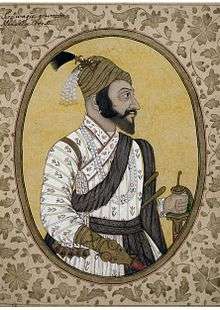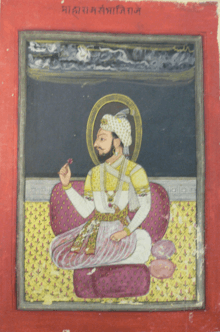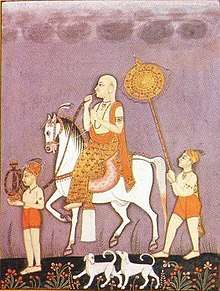Chhatrapati
Chhatrapati (Devanagari: छत्रपति) is an Indian royal title. It is often taken to be the equivalent of king or emperor, and was used by the Maratha. The word ‘Chhatrapati’ is a tatpurusha Sanskrit compound of chhatra (parasol or umbrella) and pati (master/lord/ruler). The parasol was considered a symbol of absolute, or even universal, sovereignty and consecrated kingship, and has been used by monarchies outside of India, as well. The title indicates a person who is a sovereign ruler over other princes, and not a vassal. In contrast, the Indian titles of Maharaja or Raja, Yuvraj, Rajkumar or Kumar, and Senapati, reflect a range of European equivalent meanings, from King, Crown Prince, and Prince, to Duke, Count, or Lord. Shivaji adopted 'Chhatrapati' it since other titles were bestowed by other lieges and paramount rulers, like the Adilshahi or Mughals.
House of Bhosle

The following list details the Chhatrapatis of the House of Bhosle. The title was held by his successors, although the increasing power of the Peshwas and later Maratha generals reduced it to a nominal position. The Grand Princes of Satara were generally considered the inheritors of the title, although the Rajas of Kohlapur did have a claim by descent, as their position began as a subsidiary title of Shivaji II due to location of his court. His mother, the Regent Tarabai, established a rival regime in Kohlapur, challenging both the power of the Peshwas and the Mughal-backed claims of Shahu.[1]
| Portrait | Chhatrapati | Birth | Reign | Death |
|---|---|---|---|---|
 |
Shivaji | c. April 1627 / 19 February 1630[2] | 1674 - 1680 | 3 April 1680 |
 |
Sambhaji | 14 May 1657 | 20 July 1680 - 11 March 1689 | 11 March 1689 |
| Rajaram | 24 February 1670 | 1689 – 1700 | 3 March 1700 | |
 |
Shivaji II | 9 June 1696 | 1700 – 1708 | 14 March 1726 |
 |
Shahu | 18 May 1682 | 1708 – 1748 | 15 December 1749 |
Chhatrapatis of Satara
The following is the list of the Chhatrapatis of Satara.[3] After 1848 they became pensioners of the East India Company.
- Shahu (1708–1748)
- Ramraja (1749–1777) -Grandson of Rajaram and his senior wife, Tarabai.
- Shahu II of Satara (1777–1808)
- Pratapsingh (1808–1839)
- Shahaji II of Satara (1839–1848)
- Pratapsinh Raje(1865-1874)
- Rajaram Maharaj-3(1874-1904)
- Pratapsinh Raje-2(1914-1925)
- Shahu III of Satara(abba saheb)(1925-1960)
- Pratapsinhraje(1960-1978)
- Udayanraje(1978-Till Now)
Rajas of Kolhapur
The following is the list of the claimants from Kolhapur:[3]
- Tarabai as a regent of Shivaji II (1700–1708)
- Shivaji II (1700–1712) - son of Rajaram and his senior wife, Tarabai.
- Sambhaji II (1712–1760) - son of Rajaram and his junior wife, Rajasbai.
- Shivaji III (1760–1812) -
- Sambhaji III (1812–1821)
- Shivaji IV (1821-1822)
- Shahaji I (1822–1838)
- Shivaji V (1838–1866)
- Rajaram II (1866–1870)
- Shivaji VI (1871–1883)
- Shahu I also known as Rajarshi Shahu(1874–1922) (adopted from the ruling Ghatge family of Kagal)
- Rajaram III (1922–1940)
- Shivaji VII (1941–1946)
- Shahaji II (1947-1949)
- Shahu II as titular Maharaja (1983–present) (adopted from Bhosale family of Nagpur)
See also
Notes
- ↑ Sailendra., Sen, (2013-01-01). Textbook of medieval indian history. Primus Books. ISBN 9789380607344. OCLC 822894456.
- ↑ Indu Ramchandani, ed. (2000). Student’s Britannica: India (Set of 7 Vols.) 39. Popular Prakashan. p. 8. ISBN 978-0-85229-760-5.
- 1 2 Maheshwari, K.K. & K.W. Wiggins (1989). Maratha Mints and Coinage, Nashik: Indian Institute of Research in Numismatic Studies, pp.205–6
References
- ^ V.S. Kadam, 1993. Maratha Confederacy: A Study in its Origin and Development. Munshiram Manoharlal Publishers, New Delhi.
- D.B. Kasar, Rigveda to Rajgarh – Making of Shivaji the Great. Manudevi Prakashan, Mumbai.